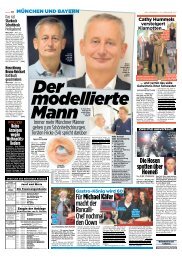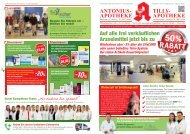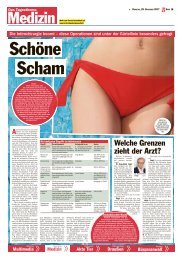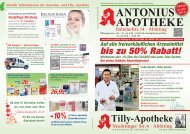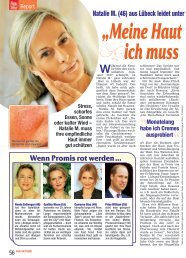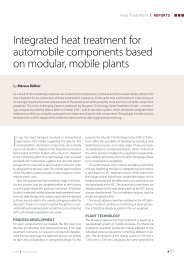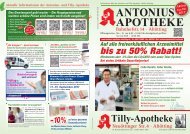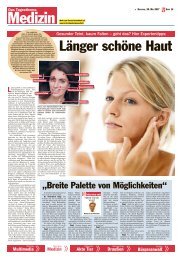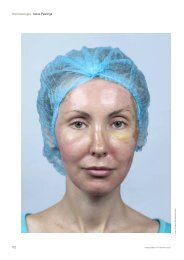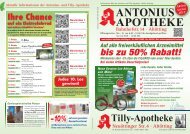Heat Processing 3.2017 ALUVATION
In der englischsprachigen Ausgabe der Heatprocessing 3.2017 wird das System ALUVATION vorgestellt
In der englischsprachigen Ausgabe der Heatprocessing 3.2017 wird das System ALUVATION vorgestellt
You also want an ePaper? Increase the reach of your titles
YUMPU automatically turns print PDFs into web optimized ePapers that Google loves.
<strong>Heat</strong> Treatment<br />
REPORTS<br />
Integrated heat treatment for<br />
automobile components based<br />
on modular, mobile plants<br />
by Marcus Rüther<br />
As a result of the increasingly intensive use of aluminium components in present and future automobiles, demand for<br />
heat treatment for the production of these components is growing. At the same time, heat treatment is becoming an<br />
increasingly important process step because of the growing demands posed by more and more complex component<br />
properties. This is the challenging situation addressed by Aluvation Technology Center Paderborn GmbH – a technology<br />
company founded by Markus Belte in October 2016 – with its Aluvation system, which reinterprets integrated heat<br />
treatment by offering a complete package for the treatment of automobile components. The package includes process<br />
development and the supply of the treatment plant as well as data logging and processing.<br />
It was the road transport involved in conventional<br />
approaches that initially suggested the idea for this<br />
reinterpretation. Aluminium components are normally<br />
cast at one location, shipped to the treatment contractor,<br />
heat-treated, and then loaded onto a truck for shipment<br />
to the machining plant. The road haulage costs involved<br />
are significant. Furthermore, capital is tied up in the interim<br />
storage which is required at each location involved in order<br />
to safeguard the process chain. The mobile plant modules<br />
of the Aluvation system provide a radical solution which<br />
reduces these costs.<br />
With the system, the heat treatment stage in the production<br />
process may be completed either at the foundry<br />
or at the plant where the parts are machined. Whichever<br />
location is selected, neither separate heat treatment knowhow<br />
nor data storage and analysis capacities are required<br />
as these are included in the overall package provided by<br />
Aluvation. There is no need to transfer the parts to a conventional<br />
heat treatment plant and all the costs connected<br />
with such shipping operations are saved.<br />
PROCESS DEVELOPMENT<br />
For each component to be treated, the first step is to<br />
develop an individual heat treatment process. If the heat<br />
treatment contractor is involved in component development<br />
from an early stage, the treatment process can already<br />
be taken into consideration in component design. For this<br />
purpose, the Aluvation Technology Center (ATC) in Paderborn<br />
offers the possibility of developing individual heat<br />
treatment processes at an early stage. These processes<br />
are developed on standardized plants, which means that<br />
the entire process including the equipment required has<br />
been reliably defined by the time when the design phase<br />
for a component is completed.<br />
The entire process, from solution annealing, quenching<br />
and age hardening through to straightening and testing,<br />
is developed on ATC treatment plants. At the same time,<br />
the charge carriers, which have considerable impact on the<br />
treatment process and the deformation of components, are<br />
also developed at the ATC. The aluminium components are<br />
already treated on the near-series plants at the ATC during<br />
process development. This constellation ensures that the<br />
results are reproducible.<br />
The results obtained are then validated in the ATC laboratory.<br />
The direct, continuous monitoring of series production<br />
is therefore already possible in the run-up phase.<br />
PLANT TECHNOLOGY<br />
The Aluvation approach to heat treatment is based on a<br />
standardized system of mobile modules. It is therefore<br />
possible to assemble production plants adapted to the<br />
individual process required by combining different modules.<br />
The dimensions of the charge carriers (1,700 mm x<br />
1,700 mm x 1,700 mm) are always the same while all the<br />
3-2017 heat processing<br />
83
REPORTS<br />
<strong>Heat</strong> Treatment<br />
Parts/Day<br />
7000<br />
6000<br />
5000<br />
4000<br />
3000<br />
2000<br />
1000<br />
0<br />
2014 2016 2018 2020 2022 2024 2026<br />
Fig. 1: Daily production run-up curve for components<br />
Production year<br />
other parameters can be adapted to the individual process<br />
or charge material.<br />
The individual modules are designed and installed as<br />
containers which are suitable for road haulage, allowing the<br />
highest possible degree of flexibility in plant deployment.<br />
The furnace modules are designed and produced by Tenova<br />
LOI Thermprocess GmbH. They consist of roller hearth<br />
furnaces which can be operated both as batch-type and<br />
as continuous treatment furnaces. The electrically heated<br />
furnaces feature highly homogeneous air recirculation with<br />
specially developed air guide systems.<br />
As the plant components and modules used are always<br />
the same, virtually any module can be combined with any<br />
other module. This means that the capacity of the plant<br />
can be flexibly adapted to the production volume actually<br />
required at any time.<br />
It is possible to start with a small plant, e. g. a chamber<br />
furnace, and then to adapt to changed requirements as a<br />
result of growing production volumes by installing additional<br />
modules.<br />
This plant technology means that aluminium components<br />
can already be produced at an early stage, during<br />
process development, as individual parts or in small series<br />
using plants of the same types that are later to be used<br />
for production.<br />
The development of the plant and the relevant cost<br />
always reflect actual demand. This means that the plant can<br />
be extended in stages during the ramp-up phase and gradually<br />
reduced in size when production is declining (Fig. 1).<br />
Furthermore, the modules can be relocated within the<br />
Planned<br />
Forecast<br />
production flow at any time<br />
as they are not connected to<br />
building systems. This relocation<br />
may be necessary if<br />
Actual<br />
additional process steps are<br />
added or deleted, requiring<br />
a reconfiguration of the production<br />
plant.<br />
The modules available<br />
include several furnace modules,<br />
an air quench module<br />
and a media quench module.<br />
The conveyor systems<br />
are configured in accordance<br />
with site requirements for<br />
production. Various different<br />
conveyor modules are available<br />
and special individual<br />
solutions can be added as<br />
necessary.<br />
The furnace modules<br />
(Fig. 2) mainly consist of the<br />
furnace casing with insulation<br />
including heating, air recirculation and conveyor systems<br />
and switchgear. There is an inlet and outlet module<br />
with a door on one side which is open on the other side<br />
and a chamber module which is designed as a complete<br />
compact furnace.<br />
The air quench module is installed complete with air<br />
supply, conveyor system, switchgear and silencers. It is a<br />
self-contained unit which can also be installed in a production<br />
line.<br />
The media quench module (Fig. 3) consists of three<br />
units, the tanks, the pump unit and the conveyor system.<br />
The media quench module is also designed so that the<br />
solution annealing furnace can be installed in a raised position<br />
above the quench.<br />
All the modules are simply installed on the plant floor<br />
and no special foundations are needed. The modules can<br />
be positioned and commissioned within the space of a few<br />
days. As process development is completed in advance<br />
and standardized modules are used, the running-in phase<br />
which is required for fine tuning process parameters with<br />
conventional plants can be omitted. It is only necessary<br />
to finalize the interaction of the modules with the local<br />
production facility.<br />
Fig. 4 shows a chamber furnace module (550B). This is<br />
designed as a compact furnace and includes air recirculation,<br />
heating and conveyor systems as well as a switchgear<br />
assembly. The roller table upstream from the furnace is<br />
used for charging and discharging. Both units are delivered<br />
to the site as complete modules. Only the recirculation fans<br />
are removed for shipment and packed separately.<br />
84 heat processing 3-2017
<strong>Heat</strong> Treatment<br />
REPORTS<br />
The furnace consists of three zones, each of which can<br />
accommodate one charge carrier. Each zone is equipped<br />
with a recirculation fan and can be controlled and heated<br />
individually. The roller table upstream from the furnace<br />
is designed so that a fork-lift truck can be used for material<br />
handling and for the charging and discharging of the<br />
furnace in batch operation.<br />
CHARGE CARRIERS<br />
Even though the dimensions of the charge carriers are<br />
defined by the furnace modules, the carriers still offer<br />
a wide variety of design options and allow the installation<br />
of specific internal for the parts to be treated. These<br />
are adapted to the size and shape of the individual<br />
parts. Only the external dimensions of the charge carriers<br />
and the design of the bottom, which is important<br />
for handling, are fixed. The charge carrier has a size of<br />
1,700 mm x 1,700 mm x 1,700 mm.<br />
The charge carriers may form a complete unit or consist<br />
of several carriers positioned in a stack, provided that<br />
the height does not exceed the maximum charge carrier<br />
height of the furnace.<br />
There are no limits to the individual design of component<br />
mounts. The nozzle arrangements in the furnace and<br />
the air quench as well as the media quench are designed<br />
to allow the treatment of parts with a very wide range of<br />
shapes and sizes.<br />
Especially in the case of the heat treatment of structural<br />
components, the development of the charge carriers is a<br />
key factor as the proper positioning of the parts minimizes<br />
deformation during treatment. This allows subsequent<br />
straightening work to be substantially reduced.<br />
The individual charge carriers must be designed in such<br />
a way as to support sensitive parts of the component and<br />
to take account of effects from the casting process.<br />
All charge carriers are designated using an unambiguous<br />
code to identify the carrier itself and the componentspecific<br />
internals used. This allows the tracing and recording<br />
of the charge carrier and the charge. The heat treatment<br />
programme used is adapted to the charge carrier and the<br />
charge. If the charge on the incoming charge carrier is not<br />
suitable for the heat treatment process currently selected,<br />
the furnace can refuse to receive the charge carrier.<br />
DIGITAL TRANSFORMATION<br />
The innovative approach of the Aluvation system includes<br />
a complete package of process development, process control,<br />
plant design, plant supply and plant monitoring. Relayr<br />
GmbH, Munich, Germany, has been included as a process<br />
partner which develops a special system for plant moni-<br />
Fig. 2: Basic furnace module<br />
3-2017 heat processing<br />
85
REPORTS<br />
<strong>Heat</strong> Treatment<br />
Fig. 3: <strong>Heat</strong> treatment line assembled from modules, with media quench<br />
toring. This allows the individual predictive maintenance<br />
of plants, supports the holistic approach and facilitates<br />
integrated data handling. The Relayr modules can be used<br />
with any plant. They ensure that deviations between the<br />
required and actual data of plants installed throughout the<br />
world can be recorded and analyzed at a central location.<br />
Modules are monitored directly at the Aluvation Technology<br />
Center (ATC) in Paderborn. The process documentation<br />
required is produced centrally, processed and made<br />
available to the respective recipients in digital form. This is<br />
in line with the approach of Industry 4.0, which paves the<br />
way for the digital orientation of future production facilities.<br />
Thanks to the central storage of data and treatment<br />
programmes, process adjustments which may be required<br />
during production can be made on a specific date for all<br />
identical components, even at short notice. This also applies<br />
if Aluvation plants are used for heat treatment at various<br />
locations throughout the world.<br />
Fig. 4: Photo of a 550B chamber furnace module<br />
MOBILE HEAT TREATMENT<br />
Aluvation therefore offers tailor-made solutions for the<br />
heat treatment of all aluminium components using mobile<br />
plants. Thanks to central plant and process monitoring,<br />
no process documentation infrastructure is required at<br />
the installation sites of the plants. All the data can be collected<br />
centrally, processed to generate batch reports and<br />
transferred to the respective recipients, such as car makers,<br />
in digital form.<br />
The integrated modular design of the plants means that<br />
it is possible to produce pre-series parts or to meet peak<br />
production demand using other plants or at provisional<br />
installation sites at the same time as ensuring compliance<br />
with process requirements.<br />
As soon as the production volume for a customer order<br />
calls for an independent production plant, this plant can<br />
be installed directly next to the foundry, e. g., and heat<br />
treatment can be carried out on site without further preparatory<br />
stages or the specific development of the heat<br />
treatment process.<br />
As a result of central data logging and the use of identical<br />
modules, treatment can be carried out at any location<br />
which may be required during the production of the<br />
components. For example, the treatment plant may be<br />
installed at the foundry, at the machining shop, at the surface<br />
treatment plant or at any other location on the route<br />
taken by the components.<br />
A FRANCHISE SYSTEM MAKES THE<br />
TREATMENT MOBILE<br />
The approach of the system in its entirety is not limited<br />
to the newly designed heat treatment process based on<br />
standardized, mobile modular units which can be used in<br />
flexible, variable configurations. Aluvation provides unique<br />
flexibility, allowing tailor-made cost-optimized services<br />
to be offered to customers in line with the increasingly<br />
stringent and complex requirements they face. In future,<br />
customers will be able to choose the solution which is ideal<br />
for them from a total of three options:<br />
■■<br />
If the production volume required still remains small,<br />
the customer can have heat treatment carried out on<br />
the equipment in the Aluvation Technology Center<br />
(ATC) in Paderborn.<br />
■■<br />
Customers can also opt for heat treatment at one of<br />
the Aluvation Centers (AC) which are being established<br />
throughout the world.<br />
86 heat processing 3-2017
<strong>Heat</strong> Treatment<br />
REPORTS<br />
■■<br />
If the production volume grows or high volumes or<br />
considerable flexibility are required from the start of a<br />
project, the modules required can be installed at the<br />
customer’s plant within 1–5 days. The customer has<br />
the modules installed at its own production facility and<br />
carries out heat treatment at its own location.<br />
For Aluvation, the main focus is on flexible, reliable service.<br />
This is why the company is currently developing a<br />
franchise system with a view to developing a global network<br />
of Aluvation Centers (AC) for heat treatment together<br />
with certified partners. Initially, there are specific plans to<br />
develop Aluvation Centers at several locations in Germany.<br />
Enquiries from India, the USA, Austria, Spain and Portugal<br />
are currently being processed and further centers are to<br />
be installed in other countries.<br />
The establishment and installation of Centers in Germany<br />
represents an exciting upgrade for existing surface treatment<br />
contractors. In discussions with aluminium coating<br />
companies, Markus Belte has found that companies which<br />
have only washed and coated aluminium components to<br />
date can extend their service portfolio in a meaningful way<br />
by offering heat treatment services. In combination with<br />
the modular Aluvation system, coating plants can become<br />
Aluvation Centers and round off their range of services by<br />
offering standardized heat treatment. This extension can<br />
be completed without investments, which could present<br />
an obstacle, at transparent rental conditions based on production<br />
volumes.<br />
STANDARDIZATION AS A KEY ELEMENT<br />
The standardization of modular plants and processes in<br />
combination with digital transformation represents the key<br />
element in the step forward to a new era in heat treatment.<br />
In order to create a system that was really new and<br />
innovative, Aluvation was based on the holistic analysis and<br />
integration of all the elements involved in a process. For<br />
the first time, a standard process was developed in which<br />
the process parameters for heat treatment are harmonized<br />
with the appropriate charge carrier. This means that, irrespective<br />
of where the customer produces its components<br />
and charge carriers, the plant, which has a standard design,<br />
will always receive the updated process parameters via<br />
a digitalized interface. This applies irrespective of where<br />
Aluvation plants are installed throughout the world. With<br />
this approach, costly, time-consuming test runs are a thing<br />
of the past.<br />
The processes and services of Aluvation will act as multipliers<br />
and will be offered in transparent, standardized<br />
form at the same base prices throughout the world. This<br />
consistent approach heralds a revolutionary transition to<br />
the heat treatment of the future.<br />
CONCLUSION<br />
Thanks to the standardized modules of the mobile, integrated<br />
heat treatment plants, the Aluvation system makes<br />
it possible to develop processes through to series maturity<br />
without having installed the final production plant. This<br />
significantly reduces development times. Plants can be<br />
installed with the same configuration at different locations,<br />
ensuring constant heat treatment results.<br />
At the same time as retaining the reliability and quality<br />
of conventional production plants, the mobile heat<br />
treatment plant offers the possibility of reducing transport<br />
distances and costs, conserving resources and making a<br />
positive contribution to environmental protection.<br />
With integrated digital monitoring, central data analysis<br />
and the central production of batch reports, the concept<br />
also points in the direction of Industry 4.0.<br />
The transparent determination of unit costs and the<br />
possibility of hiring module containers, which reduces the<br />
capital required, together with flexible deployment possibilities<br />
lay the foundations for a new era of dynamic heat<br />
treatment.<br />
AUTHOR:<br />
Marcus Rüther<br />
ATC <strong>ALUVATION</strong> Technology Center<br />
Paderborn GmbH<br />
Paderborn, Germany<br />
Tel.: +49 (0)5254 / 80771-105<br />
m.ruether@aluvation.com<br />
Visit us at the HK 2017<br />
Vulkan-Verlag<br />
Hall 4.1 / Booth E 079<br />
25 - 27 October 2017<br />
Koelnmesse, Cologne<br />
Germany<br />
3-2017 heat processing<br />
87



